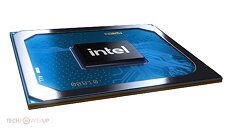Apr 10th, 2025 06:05 EDT
change timezone
Latest GPU Drivers
New Forum Posts
- Looking for input on fan placement for my Define R5 (4)
- How is the Gainward Phoenix Model in terms of quality? (2)
- Will you buy a RTX 5090? (478)
- Downgrading bios on asrock A320 board (1)
- Star Citizen (2515)
- ## [Golden Sample] RTX 5080 – 3300 MHz @ 1.020 V (Stock Curve) – Ultra-Stable & Efficient (45)
- RX 9000 series GPU Owners Club (276)
- random system shutdown with fans running at full speed (17)
- Shadow of the Tomb Raider benchmark (555)
- Do you use Linux? (573)
Popular Reviews
- The Last Of Us Part 2 Performance Benchmark Review - 30 GPUs Compared
- ASRock Z890 Taichi OCF Review
- MCHOSE L7 Pro Review
- Sapphire Radeon RX 9070 XT Pulse Review
- PowerColor Radeon RX 9070 Hellhound Review
- Upcoming Hardware Launches 2025 (Updated Apr 2025)
- Sapphire Radeon RX 9070 XT Nitro+ Review - Beating NVIDIA
- Acer Predator GM9000 2 TB Review
- ASUS GeForce RTX 5080 Astral OC Review
- UPERFECT UStation Delta Max Review - Two Screens In One
Controversial News Posts
- NVIDIA GeForce RTX 5060 Ti 16 GB SKU Likely Launching at $499, According to Supply Chain Leak (174)
- MSI Doesn't Plan Radeon RX 9000 Series GPUs, Skips AMD RDNA 4 Generation Entirely (146)
- Microsoft Introduces Copilot for Gaming (124)
- AMD Radeon RX 9070 XT Reportedly Outperforms RTX 5080 Through Undervolting (119)
- NVIDIA Reportedly Prepares GeForce RTX 5060 and RTX 5060 Ti Unveil Tomorrow (115)
- Nintendo Confirms That Switch 2 Joy-Cons Will Not Utilize Hall Effect Stick Technology (100)
- Over 200,000 Sold Radeon RX 9070 and RX 9070 XT GPUs? AMD Says No Number was Given (100)
- Nintendo Switch 2 Launches June 5 at $449.99 with New Hardware and Games (99)
News Posts matching #Fluendo
Return to Keyword Browsing
Intel Storms into 1080p Gaming and Creator Markets with Iris Xe MAX Mobile GPUs
Intel today launched its Iris Xe MAX discrete graphics processor for thin-and-light notebooks powered by 11th Gen Core "Tiger Lake" processors. Dell, Acer, and ASUS are launch partners, debuting the chip on their Inspiron 15 7000, Swift 3x, and VivoBook TP470, respectively. The Iris Xe MAX is based on the Xe LP graphics architecture, targeted at compact scale implementations of the Xe SIMD for mainstream consumer graphics. Its most interesting feature is Intel DeepLink, and a powerful media acceleration engine that includes hardware encode acceleration for popular video formats, including HEVC, which should make the Iris Xe MAX a formidable video content production solution on the move.
The Iris Xe MAX is a fully discrete GPU built on Intel's 10 nm SuperFin silicon fabrication process. It features an LPDDR4X dedicated memory interface with 4 GB of memory at 68 GB/s of bandwidth, and uses PCI-Express 4.0 x4 to talk to the processor, but those are just the physical layers. On top of these are what Intel calls Deep Link, an all encompassing hardware abstraction layer that not only enables explicit multi-GPU with the Xe LP iGPU of "Tiger Lake" processors, but also certain implicit multi-GPU functions such as fine-grained division of labor between the dGPU and iGPU to ensure that the right kind of workload is split between the two. Intel referred to this as GameDev Boost, and we detailed it in an older article.
The Iris Xe MAX is a fully discrete GPU built on Intel's 10 nm SuperFin silicon fabrication process. It features an LPDDR4X dedicated memory interface with 4 GB of memory at 68 GB/s of bandwidth, and uses PCI-Express 4.0 x4 to talk to the processor, but those are just the physical layers. On top of these are what Intel calls Deep Link, an all encompassing hardware abstraction layer that not only enables explicit multi-GPU with the Xe LP iGPU of "Tiger Lake" processors, but also certain implicit multi-GPU functions such as fine-grained division of labor between the dGPU and iGPU to ensure that the right kind of workload is split between the two. Intel referred to this as GameDev Boost, and we detailed it in an older article.

Fluendo, Lineo Solutions, Mocana and NVIDIA Join The Linux Foundation
The Linux Foundation, the nonprofit organization dedicated to accelerating the growth of Linux, today announced that four companies are joining the organization: Fluendo, Lineo Solutions, Mocana and NVIDIA. While Linux continues to see strong gains in the enterprise market (Read: Linux Adoption Trends 2012: A Survey of Enterprise End Users), its accelerated growth in other areas such as mobile and embedded development, security and multimedia is undeniable. Companies see the benefits of Linux and the collaborative development model as key advantages in the future of computing and are adopting the operating system for a variety of applications.
Apr 10th, 2025 06:05 EDT
change timezone
Latest GPU Drivers
New Forum Posts
- Looking for input on fan placement for my Define R5 (4)
- How is the Gainward Phoenix Model in terms of quality? (2)
- Will you buy a RTX 5090? (478)
- Downgrading bios on asrock A320 board (1)
- Star Citizen (2515)
- ## [Golden Sample] RTX 5080 – 3300 MHz @ 1.020 V (Stock Curve) – Ultra-Stable & Efficient (45)
- RX 9000 series GPU Owners Club (276)
- random system shutdown with fans running at full speed (17)
- Shadow of the Tomb Raider benchmark (555)
- Do you use Linux? (573)
Popular Reviews
- The Last Of Us Part 2 Performance Benchmark Review - 30 GPUs Compared
- ASRock Z890 Taichi OCF Review
- MCHOSE L7 Pro Review
- Sapphire Radeon RX 9070 XT Pulse Review
- PowerColor Radeon RX 9070 Hellhound Review
- Upcoming Hardware Launches 2025 (Updated Apr 2025)
- Sapphire Radeon RX 9070 XT Nitro+ Review - Beating NVIDIA
- Acer Predator GM9000 2 TB Review
- ASUS GeForce RTX 5080 Astral OC Review
- UPERFECT UStation Delta Max Review - Two Screens In One
Controversial News Posts
- NVIDIA GeForce RTX 5060 Ti 16 GB SKU Likely Launching at $499, According to Supply Chain Leak (174)
- MSI Doesn't Plan Radeon RX 9000 Series GPUs, Skips AMD RDNA 4 Generation Entirely (146)
- Microsoft Introduces Copilot for Gaming (124)
- AMD Radeon RX 9070 XT Reportedly Outperforms RTX 5080 Through Undervolting (119)
- NVIDIA Reportedly Prepares GeForce RTX 5060 and RTX 5060 Ti Unveil Tomorrow (115)
- Nintendo Confirms That Switch 2 Joy-Cons Will Not Utilize Hall Effect Stick Technology (100)
- Over 200,000 Sold Radeon RX 9070 and RX 9070 XT GPUs? AMD Says No Number was Given (100)
- Nintendo Switch 2 Launches June 5 at $449.99 with New Hardware and Games (99)



